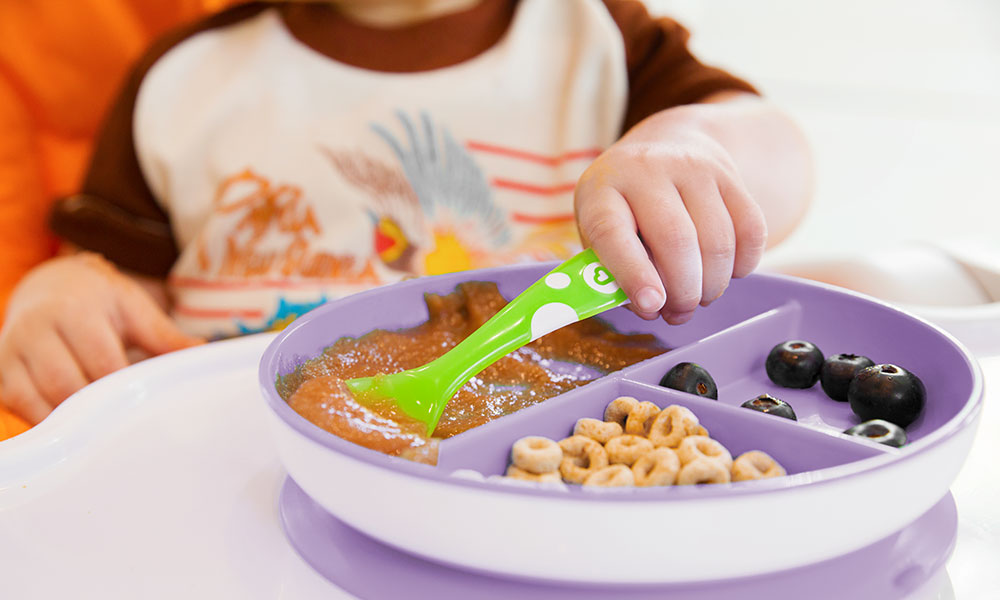Watching your little one grow and hit new milestones is an exciting journey for any parent. Introducing solid foods into their diet is a major milestone, and then teaching them to use cutlery can be a rewarding, if sometimes slightly messy and frustrating experience.
Spoons are a great place to start with cutlery, and are often the first piece that baby will tackle. For a start, they’ve likely been fed quite a bit with a spoon so are probably more familiar with it, and comfort in a familiar routine will help to get baby using the spoon. Spoons are also fairly easy to get your mouth round (literally) so baby can concentrate on getting the spoon into their mouth. Finally, it’s a great place to start because with rounded edges and no prongs your baby is less likely to catch themselves.
In this blog post, we will provide a step-by-step guide on how to teach your baby to use a spoon, ensuring a smooth transition into self-feeding.
Introduce the Spoon as a Plaything
Before diving into spoon-feeding, familiarise your baby with the spoon. Offer them a spoon during playtime to explore and become comfortable with its shape, texture, and weight. Allow them to grasp and hold it while supervised. This is a particularly important step if they haven’t had much experience with a spoon previously, because this introduction will help your baby develop a positive association with the spoon. Infant spoons are a good idea as these are designed to be gentle and easy to handle but come in eye catching and fun colours that will capture your baby’s attention.
Show and Tell
Babies learn by imitating, so it’s essential to demonstrate spoon usage. Sit face-to-face with your baby during mealtime and narrate your actions. Take a small amount of pureed food onto the spoon and bring it to your mouth, emphasising the motions of scooping and eating. It’s also a good idea for them to see that you are enjoying your food. Encourage your baby to watch and imitate you. This visual demonstration will help them understand the purpose and function of the spoon.
Offer Guided Assistance
Once your baby has observed you using the spoon, it’s time to let them try it themselves. Begin by holding the spoon with your hand over theirs. Guide their hand to scoop up a small amount of food, then bring it to their mouth. This hands-on approach allows your baby to experience the sensation of holding the spoon and helps them develop coordination.
A suction bowl can be a good idea at this point so that nothing gets knocked over or spilt which as well as being a mess can distract baby from the task in hand.
Encourage Self-Feeding
As your baby gains confidence, gradually decrease your assistance and allow them to explore self-feeding. Offer them their own spoon with a small amount of food and let them experiment. Expect some mess initially, as they are still refining their motor skills. Celebrate their efforts and provide positive reinforcement for any progress made. Allow them to practise even if it means a slower mealtime.
Practice Patience and Consistency
Teaching your baby to use a spoon requires patience and consistency. Understand that they will make mistakes and may not fully grasp the concept immediately. Be encouraging and supportive throughout the learning process. Offer opportunities for practice during each mealtime, ensuring a consistent routine. Remember that each baby is unique, and progress will vary. Celebrate their achievements, no matter how small.
Conclusion
Teaching your baby to use a spoon is an important step toward independent feeding skills. Remember to be patient and consistent, allowing your little one to learn at their own pace. With time and practice, they will soon be able to eat by themselves and move on to other cutlery and utensils as well. Enjoy this precious bonding time with your baby as you embark on this exciting journey of teaching them new skills.
If you’ve decided to be more sustainable this year and do your bit for the environment, opting for bamboo at mealtimes is a great place to start. Interested in more baby advice? Simply head to our blog or check out our StrollerCoaster podcast.

Leave a Reply